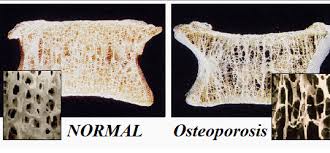Osteopenia - the basics
Osteopenia the basics. This name given to a condition caused by your losing bone density.... your bones have become 'thin'. If your bones were so thin that they became porous, you would have what the medical world calls osteoporosis. But your bones are 'thin', not porous.
(Special Note: Some people say osteopena or ostepenia but those are not the correct terms. Instead of osteopena or ostepenia, you want to say it this way: os-tea-o-peen-ee-a.)
If you have been diagnosed with 'THIN bones' there is good news. You do not have as much bone loss as those with Osteoporosis and so you are in less immediate danger of a fracture. Still 'thinning bones' is serious and you are wise to learn as much as you can. This web site offers you both basic and advanced information. I hope you will use it to educate yourself and to work out your bone building program.
Important Note: If you do not stop your bone loss, you will soon find yourself with Osteoporosis, a condition of bone loss. And with Osteoporosis your risk of multiple fractures or developing Kyphosis (dowagers hump) will be high.
Although bone thinning occurs throughout your body, your dexa scan, if you had one, usually measures the bone density in your hips and spine.( If your dexa scan showed bone thinning in your spine there is a special page about Spinal Osteopenia that you can check after reading this page..
Osteopenia the basics: bone loss is not a disease
Some call Osteopenia and Osteoporosis diseases. But technically they are not diseases. They are not like the flu, measles or pneumonia. You can not 'catch' bone loss. Instead thin bones are often the result of how we live or the result other medical condition or treatments. That is why we call excessive loss a 'condition' - not a disease.

Causes of Osteopenia. Cross cultural studies show that severe bone loss is not major problems in many parts of the world. It IS a problem in societies where people eat “Western” diet, where people develop ‘bone robbing habits’ like smoking and where they do little hard physical labor and where they take certain over the counter remedies.
Also there are other things, including SOME medical conditions and/or medical treatments that can lead to bone loss. When you finish this page, do go to the list of Causes of excessive bone loss at and make a list of all that apply to you. This list is basic for your building your personal 'game plan' to build stronger bones.
Many have found that they only make real progress when they have identified and addressed ALL their personal causes.I was one of these. Despite doing the usual recommended things I did not start rebuilding my bone density until I found ALL the causes of my bone loss....and began to address them. That is why I suggest that you read the Causes of Osteopenia, Osteoporosis page and jot down ALL that apply to you. Then you will now exactly what you need to change in order to build strong bones.
Understanding bone building
Like all the cells in the body, bone is constantly changing. Old bone is removed and new bone is formed. This process is done by two types of bone cells: Osteoclasts and Osteoblasts.
Osteoclasts remove old bone cells. Osteoblasts build new bone cells. When Osteoblasts are more active than Osteoclasts, bones grow.
The bones of children grow quickly because their Osteoblasts are more active than their Osteoclasts. As children get older the lengthening of their bones slows but bones continue to grow in density. Of course bone building is influenced by children's diet and activity. It is very important that children are physically active so as to stimulate their Osteoblasts.
Adult bone grows more slowly but your Osteoblasts (bone building cells) are more active than Osteoclasts (cells that remove bone) into your thirties.
Somewhere about the age of 35, the balance begins to shift. It is important to develop strong bone mass before age 35. You will be calling on that bone mass in future years when your Osteoclasts become more active than Osteoblasts.
Osteopenia occurs when your Osteoclasts have been removing more bone than your Osteoblasts are making and you use so much of your "total bone mass" that your bones begin to thin, you have the beginning of 'thin bones'.(Osteopenia)
Symptoms of excessive bone loss If you are interested in reading about possible symptoms, click here for Symptoms of bone loss
You can reverse bone loss: make a plan to do so
Your Osteopenia Treatment Plan should be designed to influence the ratio between the work of your Osteoclasts and your Osteoblasts. You want the work of the Osteoclasts [bone removing cells] to be slowed and/or the work of your Osteoblasts [bone building cells] increased. A really good treatment plan does both these tasks
It helps to know the Causes of your bone loss.
Then you want to read about:
- pharmaceutical treatments about
- bone building exercise and the many
- natural treatments proven to reverse bone loss
Good luck in you work to increase your bone density.
